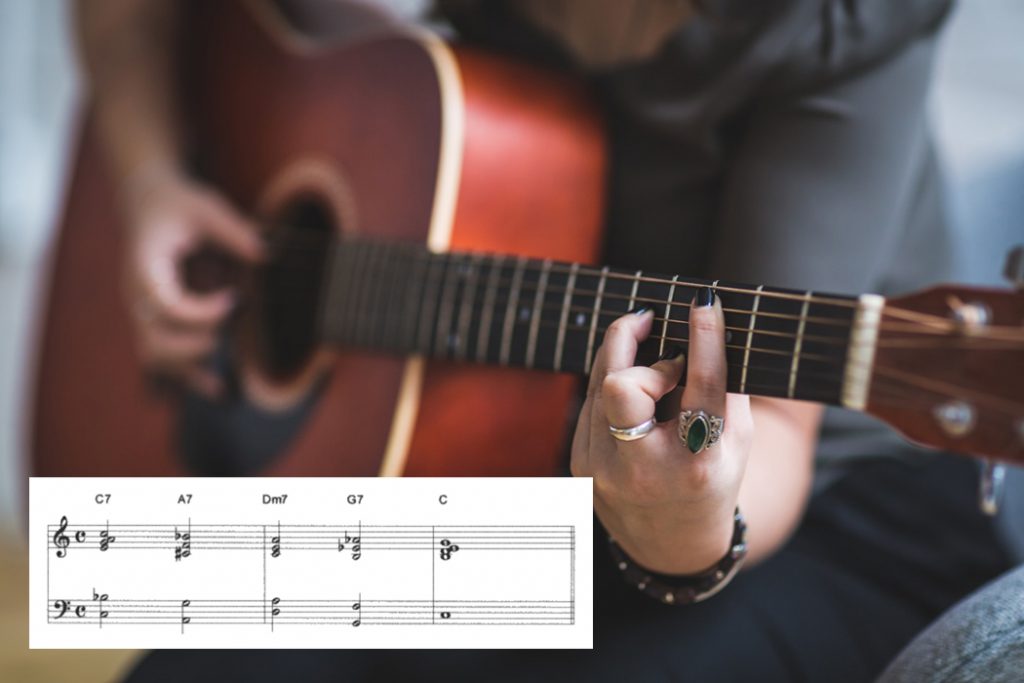+ Take your modern jazz piano and hip-hop beat making to new heights with Soundfly’s new course, Elijah Fox: Impressionist Piano & Production!
Stevie Wonder, Sting, Eric Clapton, The Beatles… Many artists have found ways to incorporate a jazz turnaround in their pop song formulas over the years. In fact, the jazz turnaround, unlike their name, do not just always appear in jazz influenced genres.
But what is a jazz turnaround and why use it in the first place?
From a songwriting perspective, the turnaround creates motion and excitement at the end of the section — which makes us long in anticipation for the next section to follow. It almost signals that the current section is soon over, and a new section will begin. All of these attributes represent pretty darn good songwriting practice.
A jazz turnaround can really take your songwriting to the next level regardless of the genre of music you’re making. So, in this post, I’d like to teach you a bit about how to use turnarounds in styles outside of jazz, such as folk, rock, and pop music.
A brief aside… We recently launched a video on our YouTube channel about a jazzy, smooth, sombre chord that we can never get enough of; also how and when to use it to full effect. Musicians, theorists, and curiosity-junkies, come one come all, and subscribe if you like that sorta thing!
Firstly and somewhat obviously, the turnaround originated in jazz music, and it typically appears at the end of a passage or a section of the song to bring the melody and chords back to a place of familiarity — since jazz improvisation can frequently take listeners to uncertain harmonic places. Over one or two bars, a turnaround is either used for leading into the next section, or to end the song.
One of the most famous jazz turnarounds is the ii-V-I. In Gershwin’s jazz standard “Someone to Watch Over Me,” the main chord progression follows as such below, with the turnaround highlighted in bold.
|| EbM7 Eb7 | AbM7 Abº7 | EbM7 Gbº7 | Bb7/F Eº7 |
| F–7 G–7 C7 | A–7b5 Bb7 | G7#5 C9 | F–7 Bb7 ||
As you can see above, the main section ends with the F–7 and Bb7 chords, leading into the EbM7 at the start of the form again, which makes a typical ii-V-I progression.
Many popular songs have borrowed this turnaround, even sometimes for constructing whole songs, such as “Sunday Morning” by Maroon 5, which almost entirely consists of the recurring ii-V-I progression.
There also have been numerous folk songs and rock classics using the ii-V-I, such as “Tears in Heaven” by Eric Clapton. However, songs like “Tears in Heaven” and “Sunday Morning” still fall into the jazzier side of contemporary music.
So, moving away from jazz a bit, how do we adapt a jazz turnaround into a rock, folk or another non-jazz genre song?
+ Learn how to marry theory, improvisation, and beat making to become a better pianist and producer, with Grammy-winner Kiefer’s Keys, Chords, & Beats.

One of the best ways to incorporate a turnaround in your song is to write the chord progressions of each section first and then work backwards from there.
So let’s say you have a song featuring a simple and common I-IV-V progression for your verse and chorus sections. In your pre-chorus section for example, you might have a IV-vi-I progression. In the key of A, that would look like this:
Verse: | A | D | E | E |
Pre-Chorus: | D | F#m7 | A | A |
Chorus: | A | D | E | E |
So let’s work backwards and add a ii-V-I turnaround to this progression right where we want to create a bit of movement before reestablishing a familiar chord. I’d choose the pre-chorus, because it’s going to sound great if we build the hype as we enter the chorus. I want the transition to the main singalong section of the song to feature respectively more activity than the chorus itself.
So, in my IV-vi-I progression, instead of repeating D-F#m7-A-A four times, I can repeat it three times and on the fourth cycle, insert my ii-V-I after the vi chord, effectively making the pre-chorus into this:
Pre-Chorus:
| D | F#m7 | A | A |
| D | F#m7 | A | A |
| D | F#m7 | A | A |
| D | F#m7 | Bm | E7 |
Chorus:
| A | D | E | E |
So what is the effect that the jazz turnaround has on this progression?
As we discussed, it creates motion away from repetition, vivifies the color, and most importantly, it signals to the listener that something is on the way, a new section is just around the bend (even if it uses the exact same chords as the verse section!). But it doesn’t come out of nowhere.
The I-vi-ii-V-I progression is actually a direct result of utilizing the circle of fifths. Just like the example above, let’s reexamine this progression in the key of A:
A – F#m – Bm – E7 – A
So if you work backwards, you will see that A to E7 is a fifth away by root motion. Then, E7 to Bm also. Then Bm to F#m. Technically, we could keep going to C#m from here but at some point we have to stop the circle and find our way home, so we will go to the relative major of F#m, which is A. And so, this is how the progression was born!
The reason the circle of fifths works so well is because harmonically it sounds strong to our ears, and it’s an easy way to get to the tonic, or the I chord in the end. However, the ii-V-I progression is always a strong case since it is based on the Circle of Fifths and so it has a direct harmonic advantage to our perception of music.
Ultimately, the purpose of the turnaround is to seamlessly make your way back into the I chord, but as if you’re taking the scenic route to get there. There are many different turnarounds that can be utilized in your songs, so I highly encourage you to do some research and see which one works best for you.
Play Your Heart Out!
Continue your learning adventure on Soundfly with modern, creative courses on songwriting, mixing, production, composing, synths, beats, and more by artists like Kiefer, Kimbra, Com Truise, Jlin, Ryan Lott, RJD2, and our newly launched Elijah Fox: Impressionist Piano & Production.




